Related Research Articles

Concho County is a county located on the Edwards Plateau in the U.S. state of Texas. At the 2020 census, the population was 3,303. Its county seat is Paint Rock. The county was founded in 1858 and later organized in 1879. It is named for the Concho River.

Presidio is a city in Presidio County, Texas, United States. It is situated on the Rio Grande River, on the opposite side of the U.S.–Mexico border from Ojinaga, Chihuahua. The name originates from Spanish and means "fortress". The population was 3,264 at the 2020 census.
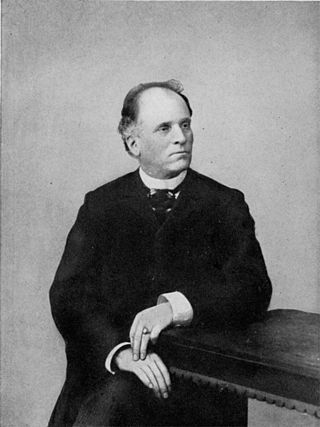
Adolph Francis Alphonse Bandelier was a Swiss and American archaeologist who particularly explored the indigenous cultures of the American Southwest, Mexico, and South America. He immigrated to the United States with his family as a youth and made his life there, abandoning the family business to study in the new fields of archeology and ethnology.
Lipan Apache are a band of Apache, a Southern Athabaskan Indigenous people, who have lived in the Southwest and Southern Plains for centuries. At the time of European and African contact, they lived in New Mexico, Colorado, Oklahoma, Texas, and northern Mexico. Historically, they were the easternmost band of Apache.
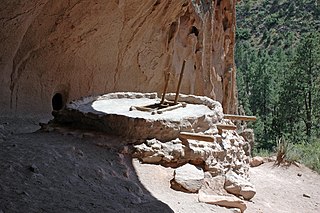
Bandelier National Monument is a 33,677-acre (136 km2) United States National Monument near Los Alamos in Sandoval and Los Alamos counties, New Mexico. The monument preserves the homes and territory of the Ancestral Puebloans of a later era in the Southwest. Most of the pueblo structures date to two eras, dating between AD 1150 and 1600.
Estevanico, also known as Mustafa Azemmouri and Esteban de Dorantes and Estevanico the Moor, was the first person of African descent to explore North America. Little is known about his background but contemporary accounts described him as a "negro alárabe" or "Arabic-speaking black man" native to Azemmour, Morocco. In 1522, he was sold as a slave to the Spanish nobleman Andrés Dorantes de Carranza in the Portuguese-controlled Moroccan town of Azemmour.
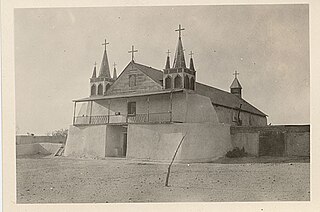
San Agustín de la Isleta Mission, founded in 1613, was a Spanish Mission in what is now Bernalillo County, New Mexico, United States. It was a religious outpost established by Spanish Catholic Franciscans, to spread Christianity among the local Native Americans.
Antonio de Espejo (1540–1585) was a Spanish explorer who led an expedition, accompanied by Diego Perez de Luxan, into New Mexico and Arizona in 1582–83. The expedition created interest in establishing a Spanish colony among the Pueblo Indians of the Rio Grande valley.
Jean L'Archevêque was a French explorer, soldier and merchant-trader. One of the few survivors of the ill-fated French colony Fort Saint Louis (Texas), L'Archevêque, the son of a merchant-trader from Bayonne, France, indentured himself to merchant-trader Sieur Pierre Duhaut in order to participate in the expedition to find the colony. L'Archevêque is known to have been the decoy that led René-Robert Cavelier, Sieur de La Salle into an ambush in which Duhaut shot La Salle. While Duhaut was killed by expedition members to avenge La Salle's murder, L'Archevêque escaped the same fate because he was viewed more favorably and was thought to be less guilty. L'Archevêque was killed in 1720 near what is now Columbus, Nebraska by Native Americans of the Pawnee tribe during the Villasur expedition.

Meoqui is one of the 67 municipalities of Chihuahua, in northern Mexico. The municipal seat lies at Pedro Meoqui. The municipality covers an area of 370 km2, making it one of the smallest in the state but one of the most densely populated.
The Chamuscado and Rodríguez Expedition visited the land on what became present day New Mexico in 1581–1582. The expedition was led by Francisco Sánchez, called "El Chamuscado," and Fray Agustín Rodríguez, the first Spaniards known to have visited the Pueblo Indians since Francisco Vásquez de Coronado 40 years earlier.

Jumanos were a tribe or several tribes, who inhabited a large area of western Texas, New Mexico, and northern Mexico, especially near the Junta de los Rios region with its large settled Indigenous population. They lived in the Big Bend area in the mountain and basin region. Spanish explorers first recorded encounters with the Jumano in 1581. Later expeditions noted them in a broad area of the Southwest and the Southern Plains.
The Manso Indians were an Indigenous people who lived along the Rio Grande, from the 16th to the 17th century. Present-day Las Cruces, New Mexico developed in this area. The Manso were one of the indigenous groups to be resettled at the Guadalupe Mission in what is now Ciudad Juarez, Mexico. Some of their descendants remain in the area to this day.
La Junta Indians is a collective name for the various Indians living in the area known as La Junta de los Rios on the borders of present-day West Texas and Mexico. In 1535 Alvar Nunez Cabeza de Vaca recorded visiting these peoples while making his way to a Spanish settlement. They cultivated crops in the river floodplains, as well as gathering indigenous plants and catching fish from the rivers. They were part of an extensive trading network in the region. As a crossroads, the area attracted people of different tribes.

The Coahuiltecan were various small, autonomous bands of Native Americans who inhabited the Rio Grande valley in what is now northeastern Mexico and southern Texas. The various Coahuiltecan groups were hunter gatherers. First encountered by Europeans in the 16th century, their population declined due to European diseases, slavery, and numerous small-scale wars fought against the Spanish, criollo, Apache, and other Indigenous groups.

The Civil Association Amigos del Pandeño was created in 2008. It is a local non-profit conservation organization based in Julimes, Chihuahua, Mexico. Its mission is to conserve and protect the Natural Heritage of the people of Julimes, Chihuahua, with special emphasis on the micro-endemic aquatic fauna which distribution range is restricted to “El Pandeño” hotspring. Through its Technical Council, Amigos del Pandeño supports scientific research and a Vital Signs Monitoring Program that informs management decision making processes that are related to the natural resources of Julimes.
Hernando de Ugarte y la Concha was Governor of New Mexico from 1649 to 1653.
Fray Juan de Salas was a Spanish Franciscan friar who provided religious instruction to the people of New Mexico and what is now Texas in the first half of the seventeenth century.
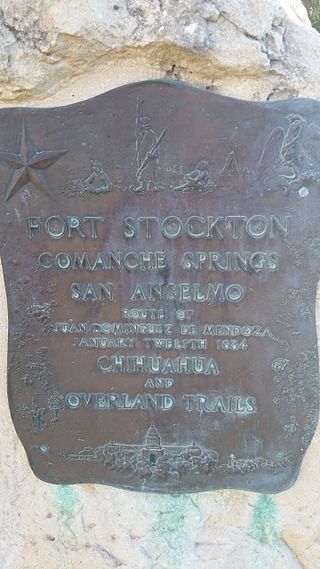
Juan Domínguez de Mendoza was a Spanish soldier who played an important role in suppressing the Pueblo Revolt of 1680 and who made two major expeditions from New Mexico into Texas.
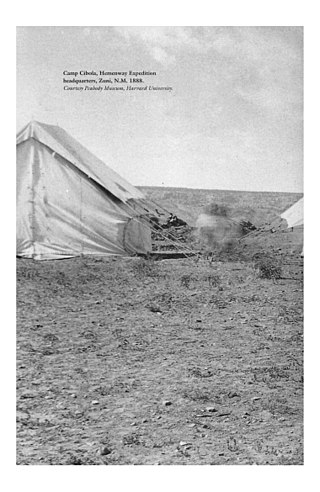
The Hemenway Southwestern Archaeological Expedition occurred between 1886 and 1894 in the American Southwest. Sponsored by Mary Tileston Hemenway, a wealthy widow and philanthropist, the expedition was initially led by Frank Hamilton Cushing, who was replaced in 1889 by Jesse Walter Fewkes. It was considered to be a major scientific archaeological expedition, notable for the discovery of the prehistoric Hohokam culture.
References
- 1 2 "American Indian Tribal Affiliation Study". npshistory.com. Retrieved 13 August 2024.
- ↑ Alternate spellings include: Xulimes, Hulimes, Geulimes, Chulimes, Jeulime. [1]
- 1 2 "Indian Assimilation in the Franciscan Area of Nueva Vizcaya". open.uapress.arizona.edu. Retrieved 13 August 2024.
- ↑ Glasrud, Bruce A.; Mallouf, Robert J. (18 September 2013). Big Bend's Ancient and Modern Past. Texas A&M University Press. p. 199. ISBN 978-1-62349-105-5.
- ↑ Bandelier, Adolph Francis Alphonse (1890). Final Report of Investigations Among the Indians of the Southwestern United States, Carried on Mainly in the Years from 1880 to 1885. . Retrieved 13 August 2024.